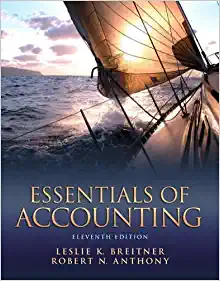Question
Y Company began the accounting period with $60,000 of merchandise, and net cost of purchases was $240,000. A physical inventory showed $72,000 of merchandise unsold
"Y" Company began the accounting period with $60,000 of merchandise, and net cost of purchases was $240,000. A physical inventory showed $72,000 of merchandise unsold at the end of the period. The cost of goods sold of Y Company for the period is:
Select one:
a. $252,000.
b. $300,000.
c. $168,000.
d. None of the above.
e. $228,000.
Question2Not yet answered
Marked out of 10.00
Flag question
Question textA business purchased merchandise for $12,000 on account; terms are 2/10, n/30. If $2,000 of the merchandise was returned and the remaining amount due was paid within the discount period, the purchase discount would be:
Select one:
a. $200.
b. $1,200.
c. $3,600.
d. $1,000.
e. $240.
Question3Not yet answered
Marked out of 10.00
Flag question
Question textOn a sales invoice, "2/10, n/30" means
Select one:
a. Nothing. Things like that are usually typos.
b. If paid within 10 days, take a cash discount of 2%. Otherwise, the full amount is due within 30 days.
c. Pay the invoice by February 10, or November 30th.
d. Pay for two items within 10 days, and the remaining items (n) within 30 days.
e. If paid within 2 days, take a cash discount of 10%. Otherwise, the full amount is due within 30 days.
Question4Not yet answered
Marked out of 10.00
Flag question
Question textThe major differences between unclassified and classified income statements are
Select one:
a. A classified income statement only has two categoriesrevenues and expenses. An unclassified income statement divides both revenues and expenses into operating and non-operating items.
b. An unclassified income statement is made available to the public, while a classified income statement is private.
c. There is no real difference. The terminology depends upon the company's industry classification.
d. An unclassified income statement only has two categoriesrevenues and expenses. A classified income statement divides both revenues and expenses into operating and non-operating items.
e. None of these.
Question5Not yet answered
Marked out of 10.00
Flag question
Question textGross margin percentage is calculated by
Select one:
a. (Gross margin divided by Net inventory turnover)*100.
b. None of these.
c. (Gross margin divided by Net sales)*200
d. (Net cost of sales divided by Net Sales)*100.
e. ((Gross margin minus non-operating expenses) divided by Gross Sales).
Question6Not yet answered
Marked out of 10.00
Flag question
Question textCurrent liabilities are obligations that:
Select one:
a. Only (x) and (y) are true.
b. (x)Are payable within one year or one operating cycle, whichever is longer.
c. (z)Are payable within one year or one operating cycle, whichever is shorter.
d. (y)Will typically be paid out of current assets.
e. Only (y) and (z) are true.
Question7Not yet answered
Marked out of 10.00
Flag question
Question textDividing net credit sales, or net sales, by average net accounts receivable yields:
Select one:
a. Receivables ageing.
b. Inventory turns.
c. Not a meaningful calculation since sales and receivables are both debits.
d. Accounts receivable turnover.
e. Asset turnover.
Question8
Not yet answered
Marked out of 10.00
Flag question
Question textWhich of the following statements is false?
Select one:
a. The percentage-of-receivables method may use either an overall rate or a different rate for each age category.
b. Any existing balance in the Allowance for Uncollectible Accounts is ignored in calculating the uncollectible accounts expense under the percentage-of-sales method except that the allowance account must have a credit balance after adjustment.
c. None of these.
d. The Allowance for Uncollectible Accounts reduces accounts receivable to their net realizable value.
e. A write-off of an account reduces the net amount shown for accounts receivable on the balance sheet.
Question9
Not yet answered
Marked out of 10.00
Flag question
Question textHunt Company estimates uncollectible accounts using the percentage-of-receivables method and expects that 5 percent of outstanding receivables will be uncollectible for 2014. The balance in Accounts Receivable is $200,000, and the allowance account has a $3,000 credit balance before adjustment at year-end. The uncollectible accounts expense for 2014 will be:
Select one:
a. None of these.
b. $13,000.
c. $10,000.
d. $7,000.
e. $9,850.
Question10
Not yet answered
Marked out of 10.00
Flag question
Question textMaxwell Company records its sales taxes in the same account as sales revenues. The sales tax rate is 6 percent. At the end of the current period, the Sales account has a balance of $265,000. The amount of sales tax payable is:
Select one:
a. $18,000.
b. $15,000.
c. $12,000.
d. $15,900.
Question11Not yet answered
Marked out of 6.00
Flag question
Question text(T / F) Credit cards are of two types nonbank credit cards (such as American Express) and bank credit cards (such as VISA).
Select one:
True
False
i need these question answered in 30 to 25 minutes asap please thank you
Step by Step Solution
There are 3 Steps involved in it
Step: 1

Get Instant Access to Expert-Tailored Solutions
See step-by-step solutions with expert insights and AI powered tools for academic success
Step: 2

Step: 3

Ace Your Homework with AI
Get the answers you need in no time with our AI-driven, step-by-step assistance
Get Started


